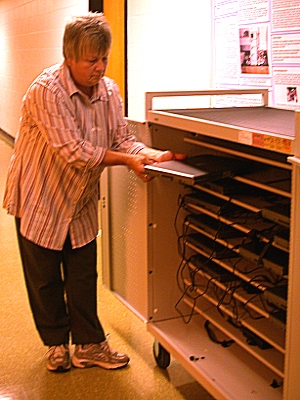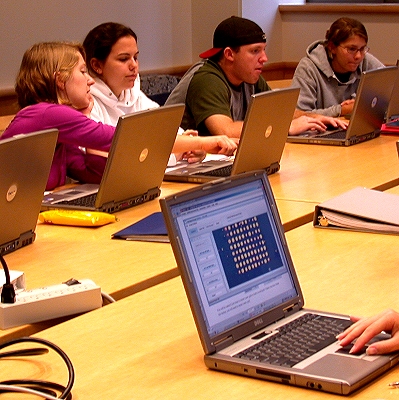Laptop PCs in the Classroom


| |
||
Evolution,
Molecular Biology, and Chemistry: Laptop PCs in the Classroom |
|
 |
 |
Laptop PCs are charged
and prepared for class by Darcy Blankenhorn, lab preparator |
Students in Karen Hicks's genetic analysis
class analyze microarray data, comparing results with each other. |
|
Evolution in the Classroom: New applications of Laptop PCs
|
|
Laptop PCs in Biology In August 2005, as part of the Biology department’s on-going initiative to incorporate technology into the classroom, 24 Dell Latitude d510 laptop computers were acquired for use by Biology faculty. Based on the recent experience of the Chemistry department, the laptops were set up and implemented promptly in classes. The laptops are housed in two computer-storage carts that can be easily connected to a power supply and the Kenyon computer network. Thus the laptops can be charged and receive any required network updates while they are stored overnight. The carts are on wheels for easy transport to classrooms and laboratories. When in use, the laptops can be easily linked to the biology building’s wireless network so that all network programs and the Internet can be utilized. The laptops were customized with biology-specific software including ArGis 9 (for landscape mapping and spatial analysis), BioPAC (used in animal physiology studies in the introductory laboratory), Dreamweaver MX (for web page construction and student project support), and bioinformatics software such as ClustralX (for multiple sequence alignments and calculating homology trees) were loaded onto each unit. The laptops were put into immediate use in the department, including in the molecular biology, animal physiology, and evolution courses. For example, in the genetic analysis course, professor Karen Hicks teachers students tomanipulate microarray data, analyzing for significant clusters of expressed genes. The PCs enable students to immediately practice the instructor's directions and try out possibilities on their own, while readily comparing their results to those of fellow students. Laptop PCs in Chemistry During the summer and fall of 2005, the Chemistry Department implemented new laptop PCs for computational chemistry exercises, laboratory data analysis and interactive classroom tutorials. Last spring, the department faculty purchased the laptops, loaded student versions of Hyperchem computational chemistry software, developed the use of student and faculty local accounts on the PCs and the protocol for connecting to the wireless network and the Kenyon LAN. Developing the local account log-in protocol now allows our computing services department to perform similar loads for other departments, such as Biology. A special cabinet was built to house the set. Work continues on maintaining the laptops, loading new and updated software and troubleshooting issues as they arise. In CHEM 123 (Introductory Chemistry Lab I), students used the laptops to analyze UV-vis absorption data, an in-class tutorial on using Excel to prepare plots of data, and later this semester will be conducting a new Hyperchem experiment in computational chemistry developed by Assistant Professor John Hofferberth. Students in CHEM 475 (Senior Research Seminar) used the laptops for three in-class tutorials on online literature searching. |